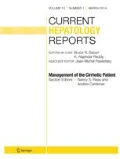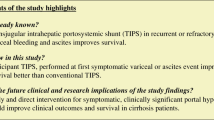Abstract
Purpose of the Review
Transjugular intrahepatic portosystemic stent shunt (TIPSS) is used to treat the complications of portal hypertension. Patient selection prior to TIPSS remains paramount for survival. This review aims to summarise the key clinical steps in patient selection prior to TIPSS and how patient selection has evolved over the last 5 years.
Recent Findings
Model for End-Stage Liver Disease (MELD) and Child-Pugh scoring in combination remain good predictors of clinical outcome post TIPSS. Minimal hepatic encephalopathy remains a diagnostic challenge, and further testing should be implemented in elective assessment. Portal vein thrombosis is no longer an absolute contraindication. The importance of diastolic dysfunction pre TIPSS remains controversial, and at present echocardiography is only recommended in patients with preexisting cardiac disease, cardiac symptoms and/or incidental abnormal ECG.
Summary
A combination of MELD, Child-Pugh, age, encephalopathy and liver imaging remain key in assessing risk pre TIPSS. A multidisciplinary team approach should be adopted for patient selection.


Similar content being viewed by others
References
Papers of particular interest, published recently, have been highlighted as: • Of importance •• Of major importance
•• Bureau C, Thabut D, Oberti F, Dharancy S, Carbonell N, Bouvier A, et al. Transjugular intrahepatic portosystemic shunts with covered stents increase transplant-free survival of patients with cirrhosis and recurrent ascites. Gastroenterology. 2017;152(1):157–63. A prospective study comparing 1-year transplant-free survival outcome of large-volume paracentesis versus covered TIPSS for refractory ascites.
Suhocki PV, Lungren MP, Kapoor B, Kim CY. Transjugular intrahepatic portosystemic shunt complications: prevention and management. Semin Intervent Radiol. 2015;32(2):123–32.
Fernandez M. Molecular pathophysiology of portal hypertension. Hepatology. 2015;61(4):1406–15.
Garcia-Pagan JC, Di Pascoli M, Caca K, Laleman W, Bureau C, Appenrodt B, et al. Use of early-TIPS for high-risk variceal bleeding: results of a post-RCT surveillance study. J Hepatol. 2013;58(1):45–50.
Colle I, Geerts AM, Van Steenkiste C, Van Vlierberghe H. Hemodynamic changes in splanchnic blood vessels in portal hypertension. Anat Rec (Hoboken). 2008;291(6):699–713.
Lotterer E, Wengert A, Fleig WE. Transjugular intrahepatic portosystemic shunt: short-term and long-term effects on hepatic and systemic hemodynamics in patients with cirrhosis. Hepatology. 1999;29(3):632–9.
Busk TM, Bendtsen F, Moller S. Cardiac and renal effects of a transjugular intrahepatic portosystemic shunt in cirrhosis. Eur J Gastroenterol Hepatol. 2013;25(5):523–30.
Boyer TD, Haskal ZJ. American Association for the Study of Liver D. The role of Transjugular Intrahepatic Portosystemic Shunt (TIPS) in the management of portal hypertension: update 2009. Hepatology. 2010;51(1):306.
de Franchis R, Baveno VIF. Expanding consensus in portal hypertension: report of the Baveno VI Consensus Workshop: stratifying risk and individualizing care for portal hypertension. J Hepatol. 2015;63(3):743–52.
Parvinian A, Shah KD, Couture PM, Minocha J, Knuttinen MG, Bui JT, et al. Older patient age may predict early mortality after transjugular intrahepatic portosystemic shunt creation in individuals at intermediate risk. J Vasc Interv Radiol. 2013;24(7):941–6.
Luca A, Miraglia R, Maruzzelli L, D'Amico M, Tuzzolino F. Early liver failure after transjugular intrahepatic portosystemic shunt in patients with cirrhosis with model for end-stage liver disease score of 12 or less: incidence, outcome, and prognostic factors. Radiology. 2016;280(2):622–9.
D'Amico G, Garcia-Tsao G, Pagliaro L. Natural history and prognostic indicators of survival in cirrhosis: a systematic review of 118 studies. J Hepatol. 2006;44(1):217–31.
• Zhou C, Hou C, Cheng D, Tang W, Lv W. Predictive accuracy comparison of MELD and Child-Turcotte-Pugh scores for survival in patients underwent TIPS placement: a systematic meta-analytic review. Int J Clin Exp Med. 2015;8(8):13464–72. This study confirms MELD scoring is better than Childs-Pugh scoring to assess overall prognosis after TIPSS, especially at 3 months.
Gaba RC, Couture PM, Bui JT, Knuttinen MG, Walzer NM, Kallwitz ER, et al. Prognostic capability of different liver disease scoring systems for prediction of early mortality after transjugular intrahepatic portosystemic shunt creation. J Vasc Interv Radiol. 2013;24(3):411–20. 20 e1-4; quiz 21
Corbett C, Murphy N, Olliff S, Mangat KS, Tripathi D. A case-control study of transjugular intrahepatic portosystemic stent shunts for patients admitted to intensive care following variceal bleeding. Eur J Gastroenterol Hepatol. 2013;25(3):344–51.
Salerno F, Camma C, Enea M, Rossle M, Wong F. Transjugular intrahepatic portosystemic shunt for refractory ascites: a meta-analysis of individual patient data. Gastroenterology. 2007;133(3):825–34.
Malinchoc M, Kamath PS, Gordon FD, Peine CJ, Rank J, ter Borg PC. A model to predict poor survival in patients undergoing transjugular intrahepatic portosystemic shunts. Hepatology. 2000;31(4):864–71.
D'Amico G. Developing concepts on MELD: delta and cutoffs. J Hepatol. 2005;42(6):790–2.
Turcotte JG, Child CG 3rd. Portal hypertension. Pathogenesis, management and prognosis. Postgrad Med. 1967;41(1):93–102.
Christensen E. Prognostic models including the Child-Pugh, MELD and Mayo risk scores—where are we and where should we go? J Hepatol. 2004;41(2):344–50.
Saugel B, Phillip V, Gaa J, Berger H, Lersch C, Schultheiss C, et al. Advanced hemodynamic monitoring before and after transjugular intrahepatic portosystemic shunt: implications for selection of patients—a prospective study. Radiology. 2012;262(1):343–52.
Hernandez-Gea V, Procopet B, Giraldez A, Amitrano L, Villanueva C, Thabut D, et al. Early-TIPS improves survival in high-risk variceal bleeders. Results of a Multicenter Variceal Bleeding Observational Study. Hepatology. 2016;64:47A–8A.
Manzano-Robleda Mdel C, Barranco-Fragoso B, Uribe M, Mendez-Sanchez N. Portal vein thrombosis: what is new? Ann Hepatol. 2015;14(1):20–7.
Stine JG, Shah PM, Cornella SL, Rudnick SR, Ghabril MS, Stukenborg GJ, et al. Portal vein thrombosis, mortality and hepatic decompensation in patients with cirrhosis: a meta-analysis. World J Hepatol. 2015;7(27):2774–80.
Han G, Qi X, He C, Yin Z, Wang J, Xia J, et al. Transjugular intrahepatic portosystemic shunt for portal vein thrombosis with symptomatic portal hypertension in liver cirrhosis. J Hepatol. 2011;54(1):78–88.
• Qi X, Han G, Fan DM. Management of portal vein thrombosis in liver cirrhosis. Nat Rev Gastroenterol Hepatol. 2014;11(7):435–46. An updated review on portal vein thrombosis management highlighting the consideration of TIPSS as a potential treatment option.
Bai M, Qi X, Yang Z, Yin Z, Nie Y, Yuan S, et al. Predictors of hepatic encephalopathy after transjugular intrahepatic portosystemic shunt in cirrhotic patients: a systematic review. J Gastroenterol Hepatol. 2011;26(6):943–51.
• American Association for the Study of Liver D. European Association for the Study of the L. Hepatic encephalopathy in chronic liver disease: 2014 practice guideline by the European Association for the Study of the Liver and the American Association for the Study of Liver Diseases. J Hepatol. 2014;61(3):642–59. Clear guidelines on diagnostic and management strategies for hepatic encephalopathy.
Bajaj JS. Review article: the modern management of hepatic encephalopathy. Aliment Pharmacol Ther. 2010;31(5):537–47.
Jalan R, Forrest EH, Redhead DN, Dillon JF, Hayes PC. Reduction in renal blood flow following acute increase in the portal pressure: evidence for the existence of a hepatorenal reflex in man? Gut. 1997;40(5):664–70.
Narahara Y, Kanazawa H, Fukuda T, Matsushita Y, Harimoto H, Kidokoro H, et al. Transjugular intrahepatic portosystemic shunt versus paracentesis plus albumin in patients with refractory ascites who have good hepatic and renal function: a prospective randomized trial. J Gastroenterol. 2011;46(1):78–85.
Tan HK, James PD, Sniderman KW, Wong F. Long-term clinical outcome of patients with cirrhosis and refractory ascites treated with transjugular intrahepatic portosystemic shunt insertion. J Gastroenterol Hepatol. 2015;30(2):389–95.
Schepke M, Roth F, Koch L, Heller J, Rabe C, Brensing KA, et al. Prognostic impact of renal impairment and sodium imbalance in patients undergoing transjugular intrahepatic portosystemic shunting for the prevention of variceal rebleeding. Digestion. 2003;67(3):146–53.
Rossle M. TIPS: 25 years later. J Hepatol. 2013;59(5):1081–93.
Rossle M, Gerbes AL. TIPS for the treatment of refractory ascites, hepatorenal syndrome and hepatic hydrothorax: a critical update. Gut. 2010;59(7):988–1000.
Wong F. Cirrhotic cardiomyopathy. Hepatol Int. 2009;3(1):294–304.
Grose RD, Nolan J, Dillon JF, Errington M, Hannan WJ, Bouchier IA, et al. Exercise-induced left ventricular dysfunction in alcoholic and non-alcoholic cirrhosis. J Hepatol. 1995;22(3):326–32.
Rabie RN, Cazzaniga M, Salerno F, Wong F. The use of E/A ratio as a predictor of outcome in cirrhotic patients treated with transjugular intrahepatic portosystemic shunt. Am J Gastroenterol. 2009;104(10):2458–66.
Cazzaniga M, Salerno F, Pagnozzi G, Dionigi E, Visentin S, Cirello I, et al. Diastolic dysfunction is associated with poor survival in patients with cirrhosis with transjugular intrahepatic portosystemic shunt. Gut. 2007;56(6):869–75.
• Shounak M, Vimal R, Colin S, David IS. A retrospective analysis of the impact of diastolic dysfunction on one-year mortality after transjugular intrahepatic porto-systemic shunt, liver transplantation and non-transplant abdominal surgery in patients with cirrhosis. Ann Gastroenterol. 2015;28(3):385–90. This study highlights that presence of diastolic dysfunction is not associated with increased 1-year mortality in patients with cirrhosis undergoing transjugular intrahepatic porto-systemic shunt or abdominal surgeries including liver transplantation.
Ruiz-del-Arbol L, Achecar L, Serradilla R, Rodriguez-Gandia MA, Rivero M, Garrido E, et al. Diastolic dysfunction is a predictor of poor outcomes in patients with cirrhosis, portal hypertension, and a normal creatinine. Hepatology. 2013;58(5):1732–41.
Nagueh SF, Appleton CP, Gillebert TC, Marino PN, Oh JK, Smiseth OA, et al. Recommendations for the evaluation of left ventricular diastolic function by echocardiography. J Am Soc Echocardiogr. 2009;22(2):107–33.
Armstrong MJ, Gohar F, Baker G, Nightingale P, Greaves D, Dhaliwal A, et al. Echocardiography in patients with cirrhosis does not predict the clinical outcome after Transjugular Intrahepatic Portosystemic Stent-Shunt (TIPSS). J Hepatol. 2017;66(1; Supplement):S381.
Tsien C, Shah SN, McCullough AJ, Dasarathy S. Reversal of sarcopenia predicts survival after a transjugular intrahepatic portosystemic stent. Eur J Gastroenterol Hepatol. 2013;25(1):85–93.
Nardelli S, Lattanzi B, Torrisi S, Greco F, Farcomeni A, Gioia S, et al. Sarcopenia is risk factor for development of hepatic encephalopathy after transjugular intrahepatic portosystemic shunt placement. Clin Gastroenterol Hepatol. 2017;15(6):934–6.
Author information
Authors and Affiliations
Corresponding author
Ethics declarations
Conflict of Interest
A. Dhaliwal and M.J. Armstrong each declare no potential conflict of interest.
D. Tripathi reports personal fees from Gore Medical during the conduct of the study and personal fees from Norgine outside the submitted work.
Human and Animal Rights and Informed Consent
This article contains no studies with human or animal subjects performed by any of the authors.
Additional information
This article is part of the Topical Collection on Portal Hypertension
Rights and permissions
About this article
Cite this article
Dhaliwal, A., Armstrong, M.J. & Tripathi, D. Patient Selection for Transjugular Intrahepatic Portosystemic Stent Shunt (TIPSS) Insertion in Variceal Bleeding and Refractory Ascites. Curr Hepatology Rep 16, 241–249 (2017). https://doi.org/10.1007/s11901-017-0361-y
Published:
Issue Date:
DOI: https://doi.org/10.1007/s11901-017-0361-y




